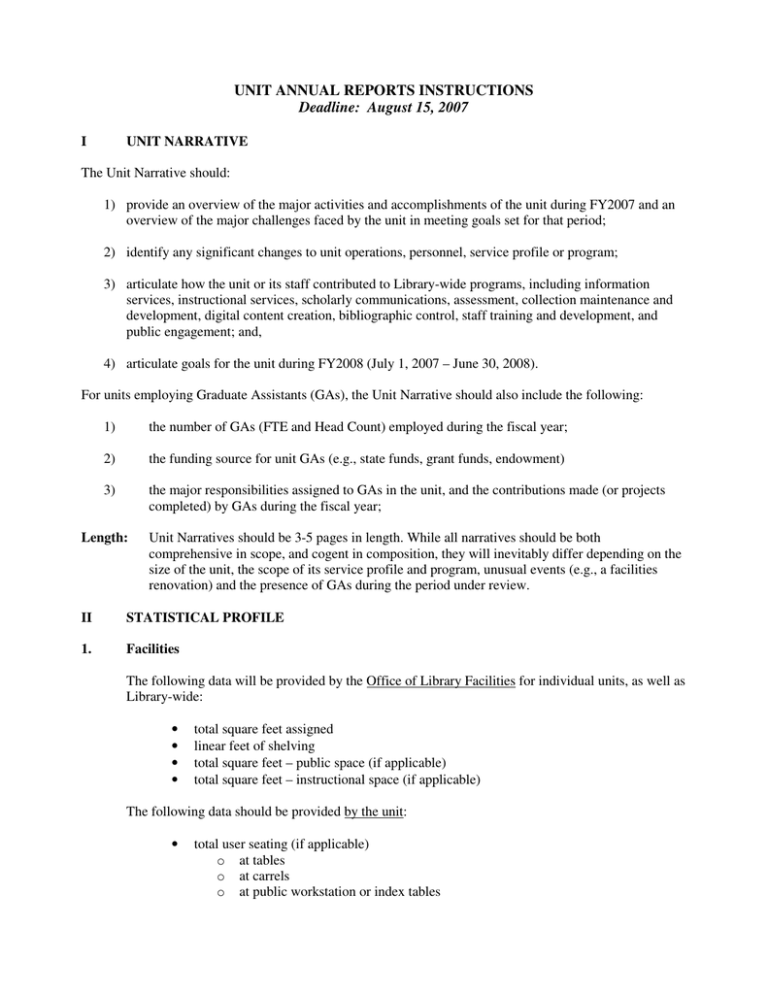UNIT ANNUAL REPORTS INSTRUCTIONS Deadline: August 15, 2007
advertisement

UNIT ANNUAL REPORTS INSTRUCTIONS Deadline: August 15, 2007 I UNIT NARRATIVE The Unit Narrative should: 1) provide an overview of the major activities and accomplishments of the unit during FY2007 and an overview of the major challenges faced by the unit in meeting goals set for that period; 2) identify any significant changes to unit operations, personnel, service profile or program; 3) articulate how the unit or its staff contributed to Library-wide programs, including information services, instructional services, scholarly communications, assessment, collection maintenance and development, digital content creation, bibliographic control, staff training and development, and public engagement; and, 4) articulate goals for the unit during FY2008 (July 1, 2007 – June 30, 2008). For units employing Graduate Assistants (GAs), the Unit Narrative should also include the following: 1) the number of GAs (FTE and Head Count) employed during the fiscal year; 2) the funding source for unit GAs (e.g., state funds, grant funds, endowment) 3) the major responsibilities assigned to GAs in the unit, and the contributions made (or projects completed) by GAs during the fiscal year; Length: Unit Narratives should be 3-5 pages in length. While all narratives should be both comprehensive in scope, and cogent in composition, they will inevitably differ depending on the size of the unit, the scope of its service profile and program, unusual events (e.g., a facilities renovation) and the presence of GAs during the period under review. II STATISTICAL PROFILE 1. Facilities The following data will be provided by the Office of Library Facilities for individual units, as well as Library-wide: • • • • total square feet assigned linear feet of shelving total square feet – public space (if applicable) total square feet – instructional space (if applicable) The following data should be provided by the unit: • total user seating (if applicable) o at tables o at carrels o at public workstation or index tables o o 2. in group study rooms informal Personnel Units should provide data on all faculty, academic professionals, civil service staff, and Graduate Assistants assigned to the unit during FY07 (FTE and head count). Data should be provided both on filled positions (permanent or temporary) and on positions that are temporarily vacant. Include cost recovery positions and staff hired for special projects and grants, but provide an explanatory footnote indicating the number of such staff. Units should provide data on student wage budget and Student Assistant FTE. For faculty, staff, and GAs, please note position type, assignments of time under 100%, and assignments that do not span the entire review period in parentheses after name, e.g.: Tim Cole (Faculty) (50%) (January – June 2007) 3. User Services The following data will be provided by the Office of Services for individual Library units, as well as Library-wide: • Gate Count (or Head Count) • Circulation o o o o o • Initial and Renewal Reserves Manual Media Other Reference Note: if not previously reported during Sweeps Week, units should provide data on digital reference transactions (IM, Chat, Docutek, E-mail) The following data will be provided by the Office of Library Facilities for individual units, as well as Library-wide: • Number of hours open to public per week o Fall o Spring o Summer I o Summer II The following data will be provided by the Office of Information Literacy Services and Instruction for individual units, as well as Library-wide: • • number of presentations to groups number of participants in group presentations 2 The following data should be provided by the unit: • number of students enrolled in independent studies or practicum experiences supervised by unit faculty or staff (provide course details) • credit course rubric and name taught by unit faculty or staff, and number of students enrolled in each (provide course details) Note: Each individual session of credit courses should also be entered in the Instruction Statistics Database. 4. Collection Management The following data will be generated from Voyager and provided by Content Access Management for individual units as well as Library-wide: • • • • • • • • • • Cataloged volumes Microfilm reels Microfiche, print, cards (may prove problematic this year, but fixable) Computer files Cartographic materials Graphic materials Audio materials Film and video materials Musical scores and parts Serials Units with added holdings in the following categories should supply data on the following materials: • • • • Uncataloged pamphlets Uncataloged materials Manuscripts Archives, printed and official records Cataloging – All cataloging statistics are to be submitted to Michael Norman, Head, Content Access Management, for inclusion in the CAM Annual Report. Acquisitions – Acquisitions will provide Library-wide data as part of its Annual Report. Units serving as acquisition units, including Asian, Law, Slavic, and Undergraduate Library, should report data as part of their individual Unit Annual Reports. 5. Preservation Nearly all units will be including some data under the category for Personnel. Few units will actually be completing tasks under the remaining sections, but it is very important that you read and complete these so that accurate data can be submitted to ARL. a. Personnel – how many FTE are engaged in preservation activities (binding prep, mending, re-housing microfilm, etc.) in your unit? Include labor provided to your unit by funds allocated to the Preservation and Conservation Departments for special projects (e.g., labor provided by Friends Preservation Funds) 3 In the table provided in the spreadsheet, list the individuals in your unit who conduct preservation activities, their percent time devoted to these activities (as represented by their fulltime equivalent – FTE), and whether they are faculty, academic professionals, or support staff. For students and GAs, please list separate combined FTEs for your unit’s regular students and GAs. For those paid out of special budgets, grants, or non-operational accounts, please list the fund paying for the individual’s time, e.g., U.S. Newspaper Project. How to calculate FTE: FTE (Full time Equivalent) is the numerical representation of full- and part-time work activities. A person working full time represents 1.00 FTE; a person working half-time represents .50 FTE. The combined labor of five persons working half time is represented by an FTE of 2.50. Calculating the percent per staff number differs based upon the length of the individual’s working week. For example, a staff member contributes 12 hours per week on preservation related activities. As a staff person, he or she works 37.5 hours/week. To calculate the FTE dedicated to preservation activities, divide the 12 hours contributed to preservation activities by the total working week of 37.5 hours. That staff person contributes 0.32 FTE to preservation. For faculty, APs, GA, and student FTE, the figure should be based on a 40-hour working week. Therefore, a student working 10 hours in a library and dedicating 5 of those hours to preservation activities represents 0.125 FTE. Example: 5 hours/40 hours = 12.5%, or 0.125 FTE b. Expenditures – unit heads should only report the expenditures from budgets managed and supervised by their libraries. Monies spent through the Friends Preservation Competition, the NEH Competition, and the Preservation and Conservation Department’s budgets will be reported by the fund managers responsible for these activities. In the first column, provide the dollars spent; in the second, include the project or a description of what the monies funded. c. In-house Conservation/Book Repair Treatments – this section refers to conservation treatments completed in-house, i.e., by staff at the University of Illinois at UrbanaChampaign from your library. Materials sent to Preservation/Conservation or outsourced for treatment will be counted in other sections, so please do not include the number of items sent from your unit to Pres/Cons. i. number of volumes given a Level 1 conservation treatment – this refers to pieces receiving simple repairs such as mending with appropriate mending tape, pamphlet binding, and or tip-ins. The entire treatment should have required 15 minutes or less to perform. ii. Number of volumes given a Level 2 conservation treatment – this refers to any treatment taking more than 15 minutes but less than two hours to complete. Very few libraries will be doing these. iii. Number of unbound sheets given conservation treatment – this refers to mending, repairs, etc., to single, unbound sheets such as manuscripts, maps, or posters. This includes encapsulating single, unbound sheets such as those noted above 4 iv. Number of photos and non-paper items given conservation treatment – this refers to audio-tapes, motion-picture film, photographs, etc., given conservation treatment. This does not refer to reformatting, i.e., creating a new item from the original. An example of reformatting would be taking a nitrate motion picture and transferring it to video v. Number of custom-fitted protective enclosures constructed – this refers to phase boxes, folding book boxes, etc., constructed in the Library by library staff. Do not count enclosures secured through Pres/Cons or via a commercial binder. Do not count re-housing microfilm in this category d. Out-Sourced Conservation/Book Repair Treatments – this section refers to conservation treatments completed by vendor that unit funds paid for. Do not include those paid for by Pres/Con funds. i. number of volumes treated – this refers to pieces receiving repairs from a professional conservator ii. number of unbound sheets given conservation treatment – this refers to pieces receiving repairs from a professional conservator iii. number of photos and non-paper items given conservation treatment – this refers to audio-tapes, motion picture film, photographs, etc., given conservation treatment by a vendor. This does not refer to reformatting, i.e., creating a new item from the original. An example of reformatting would be taking a nitrate motion picture and transferring it to video. If the project included conservation work such as repairing a damaged photo and the creation of a reformatted surrogate such as producing a new copy negative, count one activity under this category and the second under the Reformatting section iv. Number of custom-fitted protective enclosures constructed – this refers to phase boxes, folding boxes, etc., constructed by vendors. Do not count enclosures secured through preservation/conservation or via a commercial binder e. Reformatting - this section refers to materials that you reformatted through vendors. i. number of photos and non-paper items (tapes, motion pictures) reformatted – this refers to treatments in which original photographs, audio-tapes, acetate disks, etc., are transferred to a new, preservation master. An example would be transferring a home movie to Beta SP or some other commonly accepted preservation format. This treatment is generally done by vendors ii. number of books reformatted to microfilm – this refers to the number of items reformatted to preservation microfilm during FY07. Do not include items microfilmed at the Library’s microfilm services unit. iii. Number of single pages of manuscript or archival material reformatted to microfilm – this refers to the number of items reformatted to preservation microfilm during FY07. Do not include items microfilmed at the Library’s microfilm services unit. 5






